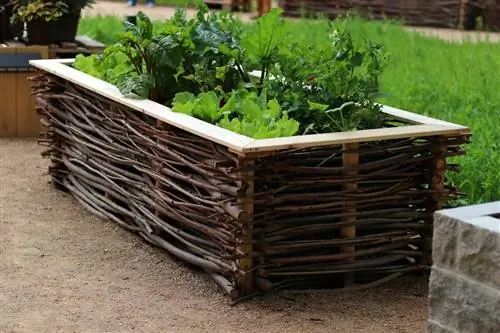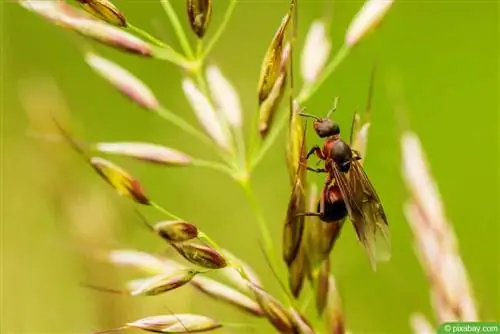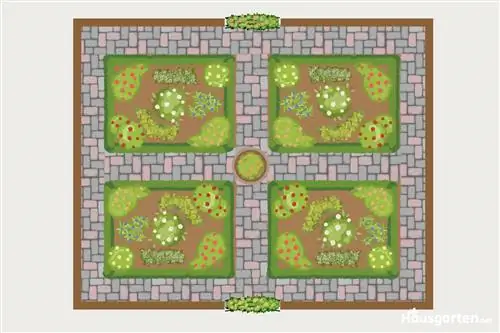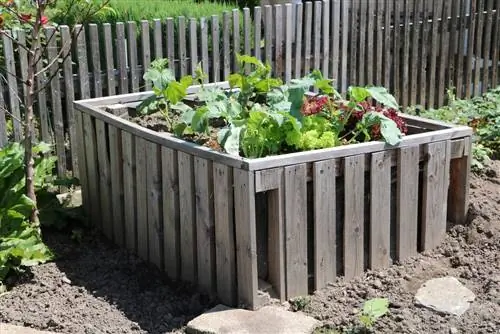- Author admin [email protected].
- Public 2023-12-17 03:39.
- Last modified 2025-01-24 12:45.
There are numerous ways to combat and get rid of ants. Natural options are sensible and environmentally friendly. This applies especially but not only when it comes to fruit or vegetables.
Why fight ants?
At first, fighting or driving away insects in the garden doesn't seem to make much sense. After all, they clear up a lot of dead animals and fallen fruit. The problem, however, is that they also literally breed aphids. These release so-called honeydew and suck out plants.
So it's not the ant itself that damages the plants, but it does contribute to it. Because the ant taps the honeydew and uses it as one of its most valuable carbohydrate sources.
Prevention
Prevention is better than cure - they say. This also applies to the ants in raised beds. If you pay close attention and take the appropriate measures in good time, you don't have to worry about fighting and driving them away. There are several options for this.
Baking powder on raised beds
Baking soda is said to keep insects away both in the house and in the garden. Drawing a boundary around the bed can help keep the first feeding insects away. Alternatively, the powder can also be spread directly on the edge of the bed.
Keep your garden close to nature
Having at least one natural corner in the garden helps to preserve biodiversity. It is also worth attracting useful animals. For example, the following factors make sense:
- avoid pesticides
- spread bird food all year round
- offer a wide variety of plants
- Hang up nesting boxes
- Do not mow the lawn in an area
- Offer hiding places
- Setting up bird baths
Note:
Check plants regularly and thoroughly for aphid infestation. With simple home remedies you can eliminate these and thus also remove a food source for the ant.
Create mixed cultures
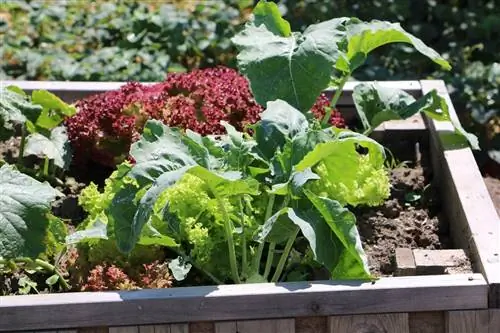
So-called monocultures are generally more susceptible to pests and diseases. Therefore, combine different plants with similar care and location requirements. This means that neither parasites nor pathogens can easily spread and greater protection is provided. Ideally, you should use intensively scented herbs, as these also have a deterrent effect.
Smells of Expulsion
Particularly intense smells have a deterrent effect not only on the ant, but also on other animals. These include, among others:
- Chili
- Vinegar
- fern fronds
- Cloves
- Lavender
- Mint
- Thyme
- Cinnamon
- Lemon
Tip:
Associated plants can be planted directly in the bed to drive away insects. Alternatively, you can use essential oils directly. Apply this to the edge of the raised bed or apply the oil to a damp cloth and cover the ant trail.
Use predators
A natural and quick variant of control is to introduce predators into the raised bed or to attract them. This at least reduces the number of ants or even scares them off completely.
Antlion
The antlion is also known as the ant maiden and builds funnel-shaped tunnels in the substrate. The insects get into it like quicksand and are eaten by the beetle. Unfortunately, this natural predator cannot be purchased and used directly. However, loose and slightly sandy soil offers an ideal habitat.
Ladybug
Ladybirds are the ideal predators and can destroy any unwanted ant. However, they eat the food source, i.e. the aphids, and thus make the raised bed uninteresting. Using breeding sets available in specialist stores and online, they can be introduced specifically into the bed and are therefore particularly practical. They themselves do not cause any damage to the plants or their fruits.
Nematodes
Nematodes are roundworms that feed on the eggs and larvae of other insects. If they can no longer find food, they slowly die. They can also be purchased online or in specialist stores. However, it is important that they are incorporated directly into the ant nest in question.
Woodpeckers and other birds
Woodpeckers and other birds are wonderful predators. One woodpecker alone can eat between 3,000 and 5,000 of the insects every day. However, they cannot be purchased. Other measures are therefore required for use.
Bugs
Bugs also feed on ants, but are difficult to plant in raised beds. However, a garden close to nature helps to maintain the natural balance.
Remove ant nest
Ant nests are often found under paving stones or near stones. This can be problematic because the animals sometimes loosen the ground through their passages to such an extent that the plates become a tripping hazard and begin to wobble. So it not only makes sense to keep the insects out of the raised bed, but there can also be other reasons to drive them away.
One option is to dig out the nest. The following step by step instructions show how it works:
1. Find ant nest
The preferred places are sheltered, warm and relatively dry. The animals can be found under pavement or patio slabs as well as under rotting wood or larger stones. If an ant trail has formed up to the raised bed, it is enough to follow it to the beginning or watch the animals on the way back.
2. Remove obstacles
If the nest is under slabs, stones or wood, these must be removed first. Wear sturdy gloves to avoid the insects' painful defensive reaction. As soon as the cover and thus the protection of the nest is removed, the ants become excited and begin to carry away the eggs and larvae. Through chemical signals, it only takes a very short time for all members of the state to be alerted. Therefore, just remove the cover and then leave the area.
3. Excavate generously
Late in the evening or early in the morning, you can dig up the nest with a spade and place it in a suitable container. For example, a bricklayer's doll or a plastic box with a lid can be used.
4. Relocate
Now move the excavated ant nest to a place from which the animals will not invade your garden again.
Alternative
Alternatively, the nest can also be floated. Allow the water to seep in slowly so that the animals have time to carry away the eggs and larvae and, for example, offer turned-over flower pots or buckets filled with soil as an alternative option. First place them upside down directly on the nest. After a day or two, you can pull the container onto a spade or board, turn it over and place it in a natural corner of the garden.

